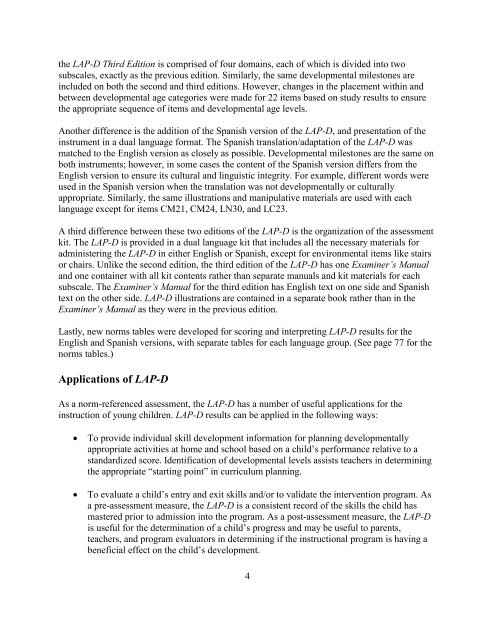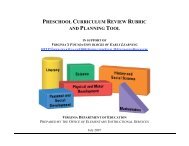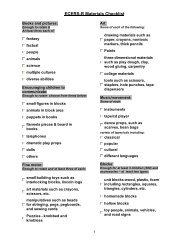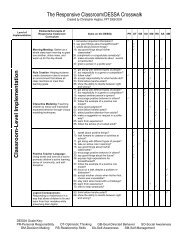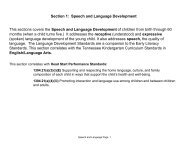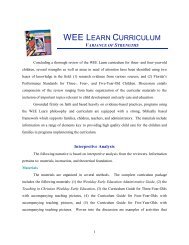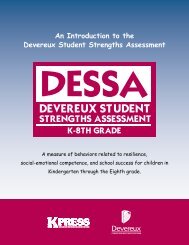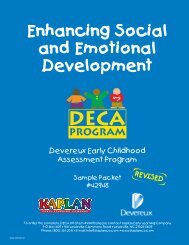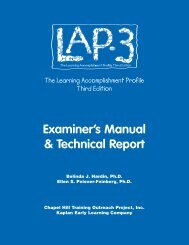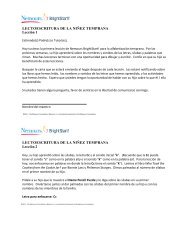the LAP-D Third Edition is <strong>com</strong>prised of four domains, each of which is divided into twosubscales, exactly as the previous edition. Similarly, the same developmental milestones areincluded on both the second and third editions. However, changes in the placement within andbetween developmental age categories were made for 22 items based on study results to ensurethe appropriate sequence of items and developmental age levels.Another difference is the addition of the Spanish version of the LAP-D, and presentation of theinstrument in a dual language format. The Spanish translation/adaptation of the LAP-D wasmatched to the English version as closely as possible. Developmental milestones are the same onboth instruments; however, in some cases the content of the Spanish version differs from theEnglish version to ensure its cultural and linguistic integrity. For example, different words wereused in the Spanish version when the translation was not developmentally or culturallyappropriate. Similarly, the same illustrations and manipulative materials are used with eachlanguage except for items CM21, CM24, LN30, and LC23.A third difference between these two editions of the LAP-D is the organization of the assessmentkit. The LAP-D is provided in a dual language kit that includes all the necessary materials foradministering the LAP-D in either English or Spanish, except for environmental items like stairsor chairs. Unlike the second edition, the third edition of the LAP-D has one Examiner’s <strong>Manual</strong>and one container with all kit contents rather than separate manuals and kit materials for eachsubscale. The Examiner’s <strong>Manual</strong> for the third edition has English text on one side and Spanishtext on the other side. LAP-D illustrations are contained in a separate book rather than in theExaminer’s <strong>Manual</strong> as they were in the previous edition.Lastly, new norms tables were developed for scoring and interpreting LAP-D results for theEnglish and Spanish versions, with separate tables for each language group. (See page 77 for thenorms tables.)Applications of LAP-DAs a norm-referenced assessment, the LAP-D has a number of useful applications for theinstruction of young children. LAP-D results can be applied in the following ways:• To provide individual skill development information for planning developmentallyappropriate activities at home and school based on a child’s performance relative to astandardized score. Identification of developmental levels assists teachers in determiningthe appropriate “starting point” in curriculum planning.• To evaluate a child’s entry and exit skills and/or to validate the intervention program. Asa pre-assessment measure, the LAP-D is a consistent record of the skills the child hasmastered prior to admission into the program. As a post-assessment measure, the LAP-Dis useful for the determination of a child’s progress and may be useful to parents,teachers, and program evaluators in determining if the instructional program is having abeneficial effect on the child’s development.4
• To assist in the identification of children with disabilities and the subsequentdevelopment of an IEP when used as a part of a multi-disciplinary evaluation. Theappropriate evaluation of young children should utilize both informal (e.g., observation,work samples) and formal techniques such as the LAP-D (NAEYC & NAECS/SDE,2003).• To conduct research on the development of preschool, kindergarten, or special needschildren.• To train teachers, paraprofessionals, clinicians, and parents on developmentallyappropriate assessment practices.• To assist early childhood programs in meeting national and state requirements (e.g., HeadStart Child Out<strong>com</strong>es, state standards)Limitations of the LAP-DThough the LAP-D has many possible applications, the examiner should apply some basicprinciples in its use. The LAP-D should never be used as a single measure for makingeducational decisions; rather, it should always be used in conjunction with a variety of formaland informal assessment procedures administered by different individuals.Children functioning at the lower end of the age range (below 36 months) may be more fullyevaluated using the Early LAP, which is designed to assess children birth to three years of age.For these children, the Early LAP assesses a wider range of behaviors below the 36-month agelevel.User QualificationsThe LAP-D is a norm-referenced instrument with clear guidelines for administration. Careshould be taken to follow these specified guidelines in order to achieve the most accurate results.Administration of the LAP-D does not require specific licensure or certification; however,training and/or experience in assessment procedures is essential for effective administration.Trained teachers, paraprofessionals, clinicians, special educators, psychologists, occupationaland physical therapists, speech-language pathologists, and others familiar with childdevelopment can administer the LAP-D. To ensure appropriate and accurate use of assessmentinformation from the LAP-D, the examiner must be<strong>com</strong>e thoroughly familiar with theExaminer’s <strong>Manual</strong> & <strong>Technical</strong> <strong>Report</strong> through self-study or professional training. TheStandards for Educational and Psychological Testing (1999) re<strong>com</strong>mends that test users “studyand evaluate the materials provided by the test developer (p. 113).” The Standards especiallyemphasize knowing the purposes, administration procedures, and appropriateness of theassessment for specific populations, as well as the reliability and validity of the assessment. Inaddition, examiners should practice administration of the assessment to help develop or improvethe skills necessary for effective administration.5
- Page 3 and 4: Initial DevelopmentDavid Wilson LeM
- Page 6 and 7: About the AuthorsBelinda J. Hardin
- Page 8 and 9: Interpreting LAP-D Profiles........
- Page 10 and 11: validity, in English and Spanish?
- Page 15 and 16: Chapter 2Overview of the LAP-DThis
- Page 17 and 18: egression procedures. This study ex
- Page 19 and 20: Table 1. Subscales of the LAP-DDoma
- Page 21: LAP-D Scoring Booklet. The Scoring
- Page 24 and 25: ecomes inattentive or severely dist
- Page 26 and 27: --When borrowing a month, borrow 30
- Page 28 and 29: Determining Starting PointsOnce the
- Page 30 and 31: Scoring Procedures RulesOnce the st
- Page 32 and 33: Figure 3a. Determining the BasalJOR
- Page 34 and 35: Ceiling RulesThe child’s ceiling
- Page 36 and 37: Additional Scoring Rules1. Administ
- Page 38 and 39: Figure 5. Computing Raw ScoresDEVAG
- Page 40 and 41: complete the Scoring Summary & Prof
- Page 42 and 43: Figure 7: Shanika’s Scoring Summa
- Page 44 and 45: Figure 9: Alan’s Scoring Summary
- Page 46 and 47: Communicating Assessment Results to
- Page 48 and 49: of training and experience required
- Page 50 and 51: sessions, one to three weeks apart,
- Page 52 and 53: Changes were made to the translatio
- Page 54 and 55: 60-65 months 183 62.4 001.8 194 62.
- Page 56 and 57: Table 6. Adults and Number of Child
- Page 58 and 59: Prior to selection of the criterion
- Page 60 and 61: additional 409 children (19.5%; n=2
- Page 62 and 63:
means, standard deviations, and cor
- Page 64 and 65:
• Comprehension30-35 months 99 08
- Page 66 and 67:
Table 12b. Internal Consistency of
- Page 68 and 69:
Table 13b. Standard Errors of Measu
- Page 70 and 71:
Test-retest reliability was determi
- Page 72 and 73:
speaking children, 8.62% were Black
- Page 74 and 75:
Table 17b. Means, Standard Deviatio
- Page 76 and 77:
Table 18b. Zero-order Correlations
- Page 78 and 79:
Table 20. Correlations Between LAP-
- Page 80 and 81:
Table 23 depicts the means, standar
- Page 82 and 83:
Age Equivalent ScoresAn age equival
- Page 85 and 86:
ReferencesAmerican Educational Rese
- Page 87 and 88:
Errata for theExaminer’s Manual &
- Page 89 and 90:
Table A-1. Percentile Rank, NCE, t-
- Page 91 and 92:
Table B-2. Percentile Ranks for LAP
- Page 93 and 94:
Table B-4. Percentile Ranks for LAP
- Page 95 and 96:
Table B-6. Percentile Ranks for LAP
- Page 97 and 98:
Table B-8. Percentile Ranks for LAP
- Page 99 and 100:
Table B-10. Percentile Ranks for LA
- Page 101 and 102:
Table B-12. Percentile Ranks for LA
- Page 103 and 104:
Table B-14. Percentile Ranks for LA
- Page 105 and 106:
30-35 MONTHS 36-41 MONTHS 42-47 MON
- Page 107 and 108:
30-35 MONTHS 36-41 MONTHS 42-47 MON
- Page 109 and 110:
Table C-1. Percentile Ranks for LAP
- Page 111 and 112:
Table C-3. Percentile Ranks for LAP
- Page 113 and 114:
Table C-5. Percentile Ranks for LAP
- Page 115 and 116:
Table C-7. Percentile Ranks for LAP
- Page 117 and 118:
Table C-9. Percentile Ranks for LAP
- Page 119 and 120:
Table C-11. Percentile Ranks for LA
- Page 121 and 122:
Table C-13. Percentile Ranks for LA
- Page 123 and 124:
Table C-15. Percentile Ranks for To
- Page 125:
Table C-16. Spanish Age Equivalents


